The passion for science, medicine, and education runs deep at Harvard Medical School—so deep, in fact, that many community members have chosen to permanently imprint representations of their specialties on their bodies.
Whether literal or abstract, bold or subtle, these works of art may reflect a subject of lifelong study; serve as a reminder of the joys, pitfalls, or guiding principles of day-to-day work; or signify an important relationship. Some bare their ink for all to see, while others keep theirs under wraps for a variety of reasons, including fear of censure within the profession.
In 2011, science writer Carl Zimmer published Science Ink, showcasing science-inspired tattoos sported by researchers and fans around the world. That project is a fitting foundation for our latest photo feature, since Sandeep Robert Datta, an associate professor of neurobiology in the Blavatnik Institute at HMS, inspired the book when Zimmer spotted his DNA tattoo, which encodes a special message.
Harvard Medicine conducted an open call for tattoos across campus departments and offices in late summer 2020. More than a dozen HMS students, trainees, staff, and faculty responded. Here, they display their career-related tattoos and share what each one means to them.
Did you miss our initial call? Share your tattoo story on social media and tag @HarvardMed on Instagram and Twitter or email it to harvardmedicine@hms.harvard.edu

Rasmus Herlo
Postdoctoral fellow, HMS Department of Cell Biology and Boston Children’s Hospital
Specialty: Neuronal cell biology and pharmacology
What do your tattoos depict?
1) The rod of Asclepius
2) Dopamine and serotonin
3) Single-stranded DNA with the sequence coding for RAS
What do they mean to you?
1) The rod of Asclepius is associated with healing, immortality, and medicine. When I received my grant to do my medical PhD program in the Department of Neuroscience in Copenhagen, I celebrated with this mythological tattoo.
2) During my PhD, my work revolved around receptors for dopamine and serotonin. These neuromodulators mediate any sensation we have of pleasure and happiness, so I’ve got a sign on my office door saying: “Dopamine and serotonin, technically the only things you really enjoy.” When I was telling that story to a tattooist in London, who was drawing another piece on my other arm, he offered to make this for free if he could hang the design in his salon. The rest is history.
3) When I moved to Boston for my first postdoc, my little sister, with whom I am very close, wanted to make a tattoo with our nicknames, Kat and Ras, intertwined. However, being a cell-biology nerd, I instead reverse-engineered to single-strand primers from the amino acid sequences KAT and RAS, which have a five-nucleotide base pairing overlap. Thus, when we stand next to each other, we become each other’s primer, and together we generate a larger product than our two individual parts.
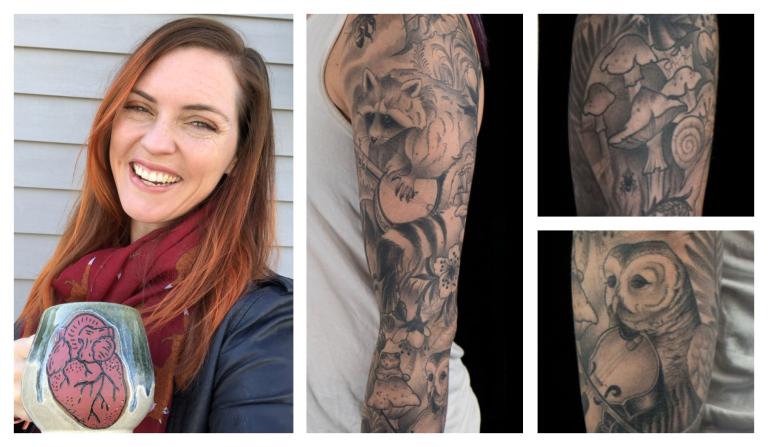
Kimberly McCabe
Teacher, HMS MEDScience program
Specialty: Education
What does your tattoo depict?
It depicts woodland animals playing instruments around a campfire
What does it mean to you?
I teach medical science at HMS MEDScience, but the core of my pedagogical training was in ecology. I got this tattoo to celebrate and commemorate my master’s degree in ecological teaching and learning. The design was created in collaboration with the artist. Every species on my arm is drawn with biological accuracy—minus the instruments, I suppose—and is found in Maine, where I spent my summer residency. It reminds me that everything is interconnected, whether we are talking about an ecosystem or the intersectionality of the subjects we teach in our school program.
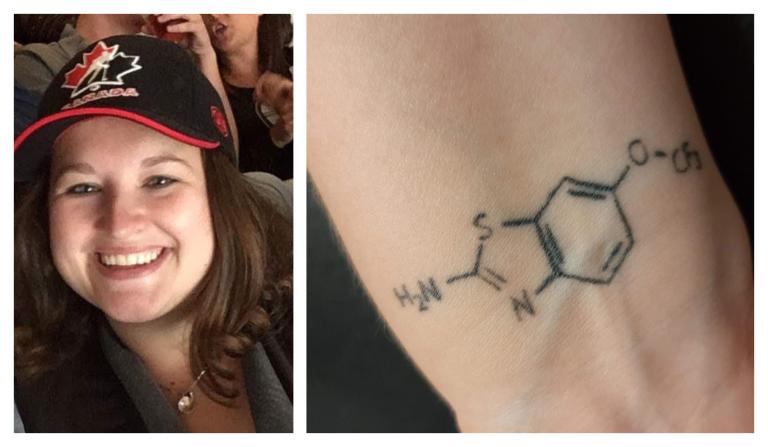
Lauren Mifflin
PhD candidate in biological and biomedical sciences, Yuan lab, Department of Cell Biology
Specialty: Neurodegeneration and neuroinflammation
What does your tattoo depict?
Chemical structure of riluzole, an ALS medication
What does it mean to you?
In fall 2016, my aunt was diagnosed with ALS. At that time, I was working as a management consultant and venture capitalist and studying for my MBA. I hadn’t set foot in a science lab in over five years.
In 2016, riluzole (the drug whose chemical structure is depicted in my tattoo) was the only approved therapy for ALS. Unfortunately, it has an effect for only about one-third of patients, and for those patients, it still doesn’t prolong life. Having been a neuroscience major as an undergrad, I realized that I had no right to be frustrated with the lack of treatments for this disease if I wasn’t willing to become part of the solution. I came to Harvard to work on new therapies for ALS, ultimately landing in Junying Yuan’s lab to study how RIPK1 inhibitors, currently in clinical trials for ALS, may be an effective therapy.
My aunt passed away about one year after her diagnosis.
Science is tough! Having my tattoo as a reminder of my aunt and why I’m doing this is what gets me through long experiments and late nights.
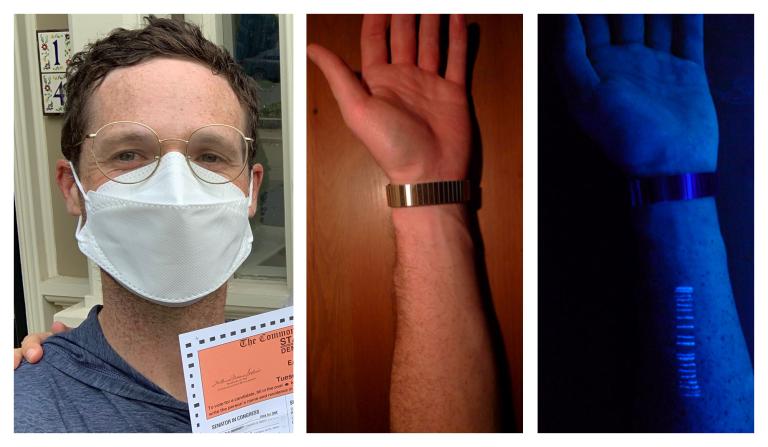
Ben Ewen-Campen
Research fellow in genetics, Perrimon lab, Department of Genetics
Specialty: Developmental genetics, CRISPR
What does your tattoo depict?
My tattoo is a DNA size standard, usually referred to as a ladder, used to estimate the size of DNA fragments.
What does it mean to you?
I love the day-to-day grunt work of bench science, and for anyone who works with DNA in any capacity, ladders like this one are old, trusted friends. They’re usually visualized under ultraviolet light, like this tattoo. I got it because my friend Arpy [Saunders, who is also at HMS] had just bought a tattoo gun and some black light-sensitive ink, and I had to come up with something quickly.
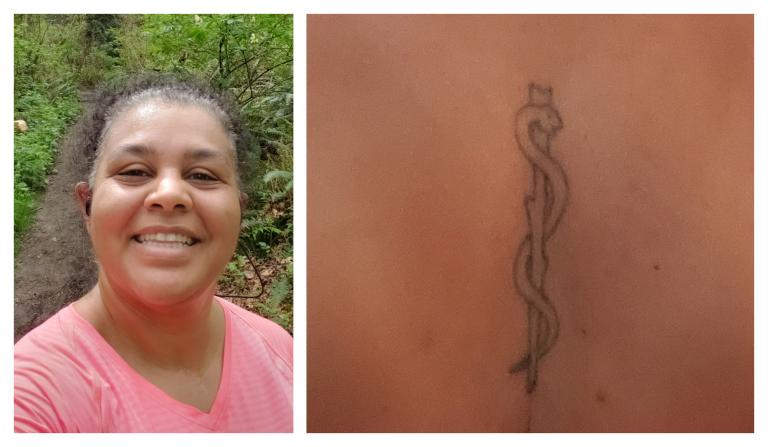
Samara Peters
Masters in bioethics candidate
Your specialty: Pediatrics
What does your tattoo depict?
The rod of Asclepius
What does it mean to you?
I’ve wanted to be a doctor since grade school. I always liked the symbolism of the rod of Asclepius, not only for the reference to Asclepius, the Greek god of healing and medicine, but also for the suggestion that it was a symbol of the treatment for guinea worm, which involves slowly wrapping the end of the worm around a stick until the worm is extracted from the body. Getting the tattoo was a celebration of my acceptance to medical school and coming into the world of medicine. I have now had the pleasure of being a practicing physician for over 10 years!
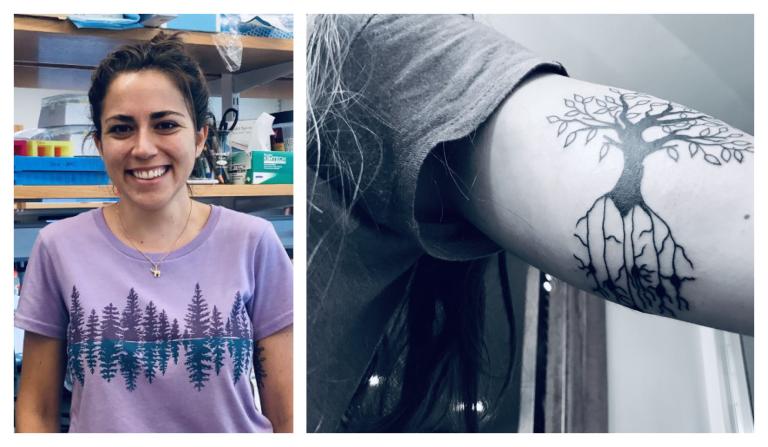
Valentina Lagomarsino
PhD candidate in biological and biomedical sciences, Chiu and Kostic labs, Departments of Immunology and Microbiology
Specialty: Microbe-neuron crosstalk
What does your tattoo depict?
Tree of life with roots that are neurons, traced from Santiago Ramón y Cajal’s illustrations
What does it mean to you?
This tattoo reminds me that we are constantly sending out signals to our environment. Like roots descending from trees, our nervous system constantly sends signals out to those around us by way of controlling our mood and behavior.
These signals are bidirectional, too. As a graduate student I am studying how microorganisms that colonize our gut affect our behaviors. I wrote a blog article for Science in the News about the parallels between the nervous system and tree root systems. It has been helpful for me to look at other ecosystems, like forests, to think creatively about what is happening in the human body.
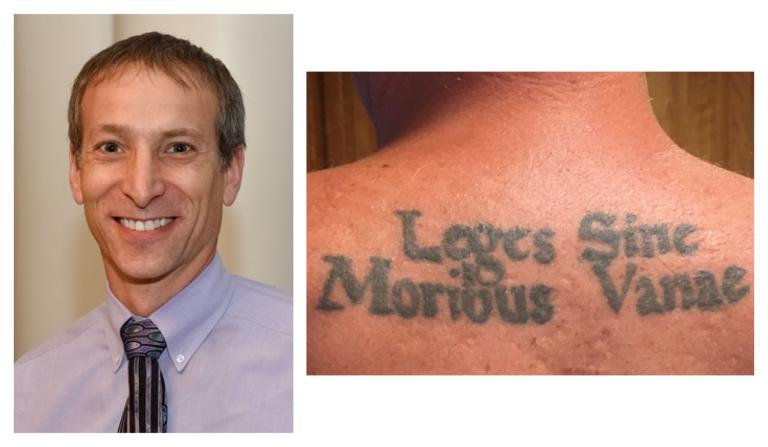
David N. Sontag
Faculty and co-director, capstone program, HMS Center for Bioethics; co-chair, Ethics Advisory Committee, Beth Israel Deaconess Medical Center; managing general counsel, Beth Israel Lahey Health
Specialty: Bioethics and law
What does your tattoo depict?
“Leges Sine Moribus Vanae”
What does it mean to you?
The Latin translates to “Laws without morals [are] empty.” I wanted a tattoo representing my dual professional interests of bioethics and law. Laws should be used to ensure a just and fair society, particularly as it relates to health and health care. Hence, laws that do not further the morals of the people are pointless.
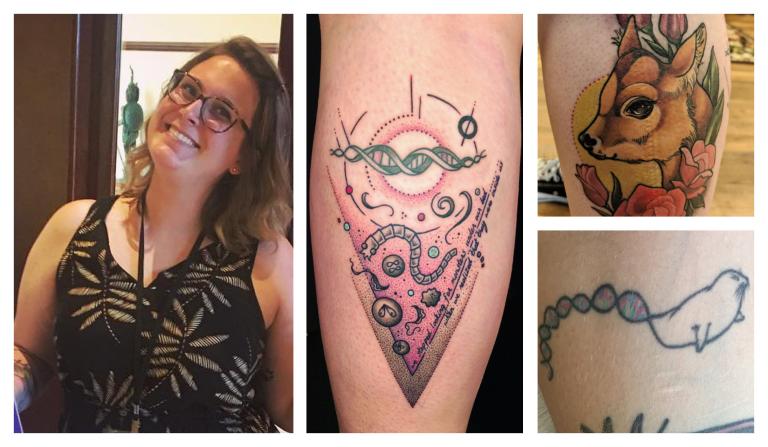
Caroline Keroack
PhD candidate in biological and biomedical sciences, Duraisingh lab, Harvard T.H. Chan School of Public Health; therapeutics certificate program, HMS
Specialty: Molecular parasitology
What do your tattoos depict? What do they mean to you?
1) Parasites
2) A calf (baby cow)
3) A seal that turns into a double helix of DNA
What do they mean to you?
1) This is a tattoo that includes every parasite I have ever worked on, including a tape worm, nematodes (worms), trypanosomes, Plasmodium (malaria), and Babesia (multiple species). There is also a DNA double helix and a quote that is often attributed to Darwin: “We stopped looking for monsters under our bed when we realized that they were inside us.”
I have studied parasites for nearly a decade. I started working on nematode infections in humans, such as lymphatic filariasis; moved to nematode infections in animals, such as dog heartworm; and am now working on single-celled parasites called Babesia, which are transmitted by ticks. I got this tattoo during the second year of my PhD at Harvard, when I was totally certain in my choice of field. I want to be a parasitologist forever! I even left some room to add new parasites if I ever get the chance to work on different ones.
2) The major focus of my PhD has been studying a parasite that causes significant disease in cows and has a major impact on agriculture. I got this cow tattoo to remember the “patients” I am doing all my PhD research for. This tattoo is right next to my parasite tattoo—a subtle nod to the closeness of the host/parasite relationship.
3) During my junior and senior year of undergrad, and for two years of my master’s degree, I studied parasitic infections of marine mammals such as seals and whales. This project was what cemented in my mind that I wanted to study parasites forever and that pursuing a PhD in the field was the right choice for me. During my master’s study I also mentored a team of five undergraduate students, whom I cherish and am so proud of. We called ourselves the “marine mammal parasite people” or MMPP. This tattoo is actually a logo I designed for our team that adorned all the posters we presented. I also made team T-shirts for us. I look back on this period of my scientific career with great fondness.

Lauren Kennedy-Metz
HMS instructor in surgery, Brigham and Women’s Hospital
Specialty: Research in psychophysiology
What does your tattoo depict?
This is my husband’s heartbeat! He also has a tattoo of mine on his arm.
What does it mean to you?
My dissertation and postdoctoral research both involved capturing and calculating heart rate metrics to estimate stress and cognitive workload in health care providers. The goal is to use information about current stress and workload states while providers are operating on a patient, for example. We want to understand ways to support their cognition and maintain optimal performance during high-risk, critical events. If it looks like they’re getting really stressed out, we hope to be able to identify that preemptively and intervene to prevent some kind of negative outcome.
I have spent lots of time collecting, cleaning, and analyzing raw electrocardiograms, or ECGs, much like the one on my arm. I even collected my husband’s ECG myself (as well as my own) so I could print the segments we ultimately got tattooed on our arms. Getting these tattoos was our gift to each other for our first wedding anniversary last August. Needless to say, this small symbol represents so much that I love in life, both personally and professionally.
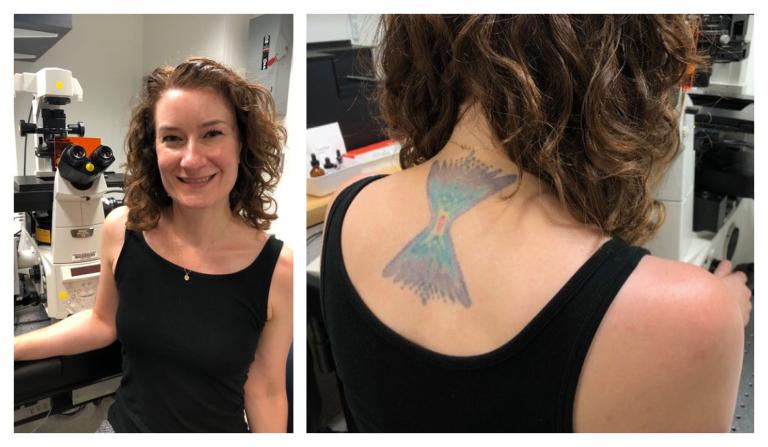
Jennifer Waters
Director, Nikon Imaging Center, Department of Cell Biology
Specialty: Microscopy
What does your tattoo depict?
The point spread function
What does it mean to you?
When optical lenses are used to form an image, the image is subject to distortion due to the diffraction and interference of light. This phenomenon can be examined by using lenses to form an image of a tiny point source of light. The resulting pattern is referred to as the point spread function, represented in my tattoo.
The point spread function limits the resolution, accuracy, and brightness of images of biological specimens that the microscope is capable of forming. I train researchers at HMS to use microscopes to generate accurate and reproducible data, and the point spread function demonstrates how important it is to understand the limitations of the instrument being used—and how to accurately interpret imaging data in spite of these limitations.
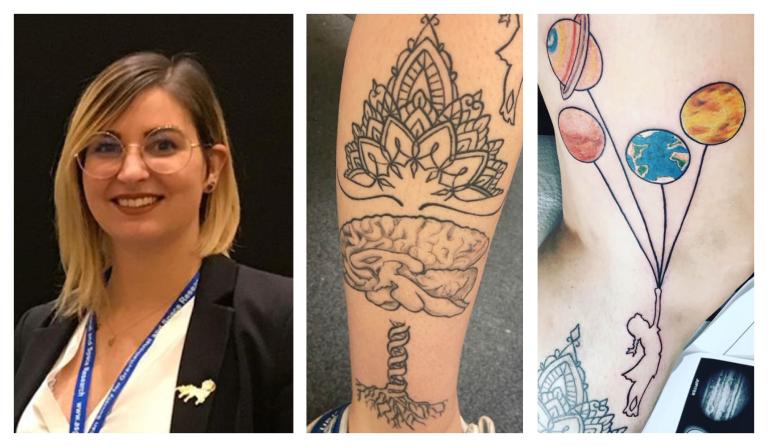
Marie Mortreux
HMS instructor in neurology, Beth Israel Deaconess Medical Center
Specialty: Musculoskeletal effects of partial gravity
What do your tattoos depict? What do they mean to you?
The first tattoo depicts my version of the tree of life. The tree has roots and DNA to represent family and my two master’s degrees in genetics. The leaves are represented by the brain, which represents knowledge and my PhD and postdoc in neurosciences. It’s topped with a mandala to represent spirituality.
The second tattoo depicts my current projects. It’s a silhouette of a little girl holding on to a few floating planets: Mars, Saturn, Earth, and Venus. For four years I have been funded by NASA to investigate the effects of partial gravity, like that on the Moon and Mars, on the body. Venus is the traditional representation for women, Earth and Mars are my main focus, and Saturn was chosen because of the rings. This sketch is inspired by Banksy’s drawing “Flying Balloon Girl.”
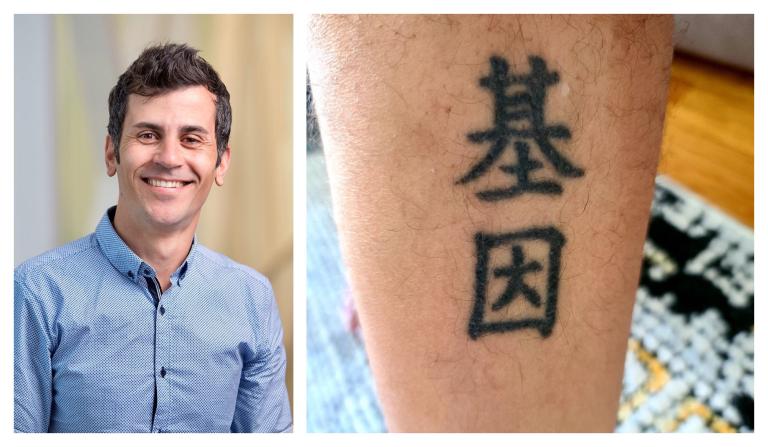
Luciano Martelotto
Scientific director, Single Cell Core, Department of Systems Biology
Specialty: Single cell genomics
What does your tattoo depict?
It means “gene” in Chinese
What does it mean to you?
I had this done when I was 18 years old, and I had no idea what it meant (I don’t speak the language); I just liked it and felt compelled to get it inked. At that stage I didn’t know I was going to do anything remotely related to genes. Curiously enough, I got interested in genes and everything related to genes once I learned what the tattoo really meant. So, it’s kind of marked my path in life. I am a bit shy of showing it, though.
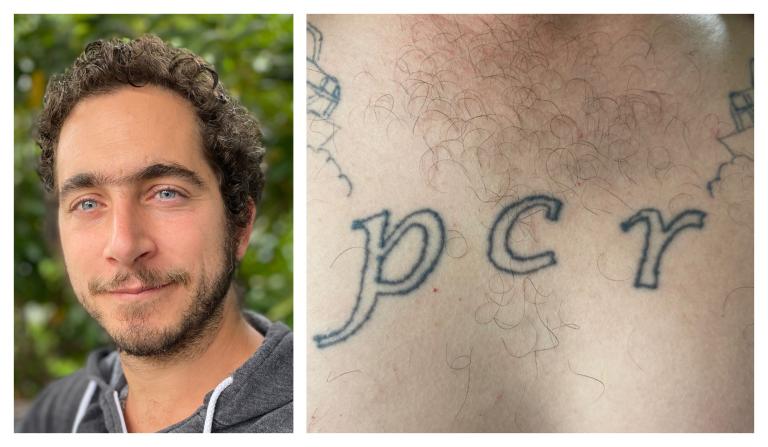
Arpiar Bruce Saunders
Research fellow in genetics, McCarroll lab, Department of Genetics
Specialty: Single-cell genomics, neuroscience
What does your tattoo depict?
The letters “PCR,” for polymerase chain reaction, a method used to amplify DNA
What does it mean to you?
I try never to forget how cool it is that we as research biologists are forced to co-opt biological phenomena to understand new biological phenomena. I love being part of that creative process. PCR is one of my favorite examples. The tattoo is homemade, given to me by an incredibly lovely collective of French artists in Berlin. We traced the letters from MS Word ’97 run off my old laptop.
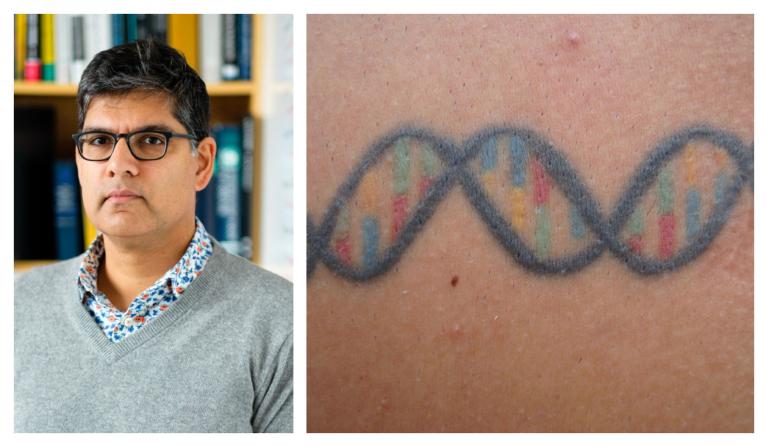
Sandeep Robert Datta
Associate professor of neurobiology, Department of Neurobiology
Specialty: The neural basis for behavior
What does your tattoo depict?
A DNA double helix that spells out my wife’s initials; green = guanine or G, amber = adenine or A, tomato red = thymine or T, and cyan = cytosine or C.
What does it mean to you?
I am a molecular neurobiologist by training, and so thinking about DNA and what it encodes is central to my worldview. I got this tattoo when my wife and I got engaged. Her initials are EEE, translated as glutamate-glutamate-glutamate, encoded by GAG or GAA. It was her gift to me!
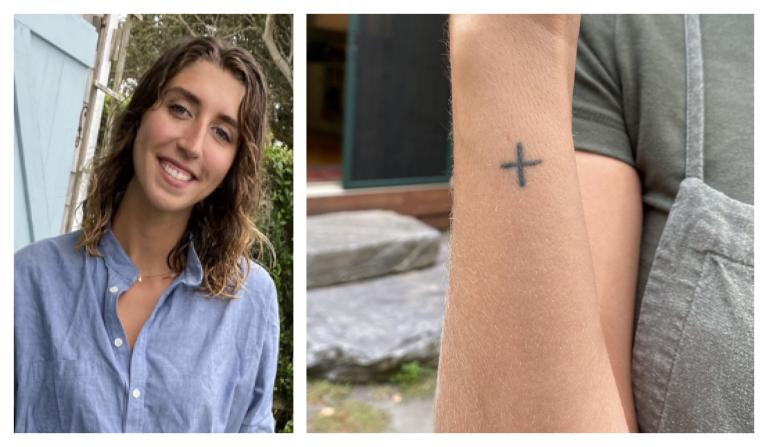
Fiona Kennedy
Teacher, HMS MEDscience program
Specialty: Program teacher
What does your tattoo depict?
My tattoo is a skeletal structure of a tetrahedral carbon molecule, a structure you would find in organic chemistry (orgo).
What does it mean to you?
I try to teach my students what my orgo professor taught me in college, which is to not be intimidated by science subjects and to realize that if something doesn’t make sense to you when taught one way, there is always another way to learn it that will better suit you. As a person who struggled in other science courses as an undergrad, I became confident in my abilities when I started looking at orgo as puzzles to solve and found passion in the pursuit. As a teacher, I try to impress upon my students that science can be both interesting and joyful for everyone.

Amber Mueller
Research fellow in genetics, Sinclair lab, Department of Genetics
Specialty: Aging muscle biology
What does your tattoo depict?
Myosin heavy chain polymerization
What does it mean to you?
My PhD was in studies of muscular dystrophy. The polymerized structure of myosin in muscle fibers allows them to contract and generate force. This myosin tattoo, disguised as a bracelet, is a nod to my past and current work studying muscle in the context of aging.

Felipe A. Pinho Ribeiro
Research fellow in immunology, Chiu lab, Department of Immunology
Specialty: Neuroimmunology
What does your tattoo depict?
A pain neuron, or nociceptor
What does it mean to you?
Pain neurons and immune cells are the sentinels of the human body. I study how pain neurons and immune cells talk to each other and the role of these neuroimmune interactions in health and disease. After 10 years of research on this topic and one neuron tattooed on my ribs, I think it is fair to say that I am a big fan of pain (studies). I am fortunate to have a sister who is a very talented tattoo artist, so I am currently trying to pick my favorite immune cell.
Stephanie Dutchen is a science writer in the HMS Office of Communications and External Relations.
Images: Images courtesy of (from top) Rasmus Herlo, Kimberly McCabe, Lauren Mifflin, Ben Ewen-Campen, Samara Peters, Valentina Lagomarsino, David N. Sontag, Caroline Keroack, Lauren Kennedy-Metz, Jennifer Waters, Marie Mortreux, Luciano Martelotto, Arpiar Bruce Saunders, Sandeep Robert Datta, Fiona Kennedy, Amber Mueller, and Felipe A. Pinho Ribeiro.